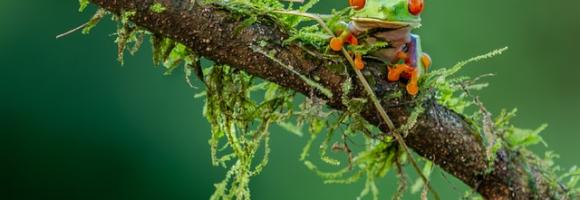
Species assessed by the International Union for the Conservation of Nature (IUCN) and documented in the IUCN Red List of Threatened Species TM (RLTS) have been used to calculate country summary statistics on the number of endemic and threatened species (IUCN, 2020).
Species included in the Red List are classified into the following categories based on Red List criteria such as rate of decline, population size, area of geographic distribution, and degree of population and distribution fragmentation:
Threatened species fall into one of the following three categories:
1) Critically Endangered (CR) – Extremely high risk of extinction in the wild.
2) Endangered (EN) – High risk of extinction in the wild.
3) Vulnerable (VU) – High risk of endangerment in the wild.
Country lists of (protected) Threatened (Critically Endangered, Endangered, Vulnerable) and Near Threatened species are derived by the previously described overlay within protected areas and species ranges,aggregating the results by the ISO3 code reported for the Protected Area by WCMC.
See http://www.iucnredlist.org/ for more details.
---
Data Uploaded by Luca Battistella using the Digital Observatory for Protected Areas Services (2022)
Threatened Amphibians
Species assessed by the International Union for the Conservation of Nature (IUCN) and documented in the IUCN Red List of Threatened Species TM (RLTS) have been used to provide end-users of DOPA Explorer with theoretical lists of species in protected areas (IUCN, 2020; Birdlife, 2019) as well as country summary statistics on the number of endemic and threatened species (IUCN, 2020). Species included in the Red List are classified into the following categories based on Red List criteria such as rate of decline, population size, area of geographic distribution, and degree of population and distribution fragmentation: Threatened species fall into one of the following three categories:
1) Critically Endangered (CR) – Extremely high risk of extinction in the wild.
2) Endangered (EN) – High risk of extinction in the wild.
3) Vulnerable (VU) – High risk of endangerment in the wild. All other species fall in these last categories:
4) Near Threatened (NT) – Likely to become endangered in the near future.
5) Least Concern (LC) – Lowest risk. Does not qualify for a more at risk category. Widespread and abundant taxa are included in this category.
6) Data Deficient (DD) – Not enough data to make an assessment of its risk of extinction.
7) Not Evaluated (NE) – Has not yet been evaluated against the criteria. The IUCN further provides information about endemic species, i.e. species occurring naturally within one country only.
Number of Threatened Species in PA
Species assessed by the International Union for the Conservation of Nature (IUCN) and documented in the IUCN Red List of Threatened Species TM (RLTS) have been used to calculate country summary statistics on the number of endemic and threatened species (IUCN, 2020).
Species included in the Red List are classified into the following categories based on Red List criteria such as rate of decline, population size, area of geographic distribution, and degree of population and distribution fragmentation:
Threatened species fall into one of the following three categories:
1) Critically Endangered (CR) – Extremely high risk of extinction in the wild.
2) Endangered (EN) – High risk of extinction in the wild. 3) Vulnerable (VU) – High risk of endangerment in the wild.
Country lists of (protected) Threatened (Critically Endangered, Endangered, Vulnerable) and Near Threatened species are derived by the previously described overlay within protected areas and species ranges,aggregating the results by the ISO3 code reported for the Protected Area by WCMC.
See http://www.iucnredlist.org/ for more details.
Number of amphibians in country reported threatened by IUCN.
Species assessed by the International Union for the Conservation of Nature (IUCN) and documented in the IUCN Red List of Threatened Species TM (RLTS) have been used to calculate country summary statistics on the number of endemic and threatened species (IUCN, 2020).
Species included in the Red List are classified into the following categories based on Red List criteria such as rate of decline, population size, area of geographic distribution, and degree of population and distribution fragmentation:
Threatened species fall into one of the following three categories:
1) Critically Endangered (CR) – Extremely high risk of extinction in the wild.
2) Endangered (EN) – High risk of extinction in the wild. 3) Vulnerable (VU) – High risk of endangerment in the wild.
Country lists of (protected) Threatened (Critically Endangered, Endangered, Vulnerable) and Near Threatened species are derived by the previously described overlay within protected areas and species ranges,aggregating the results by the ISO3 code reported for the Protected Area by WCMC.
See http://www.iucnredlist.org/ for more details.